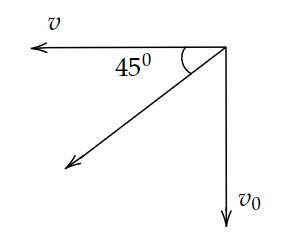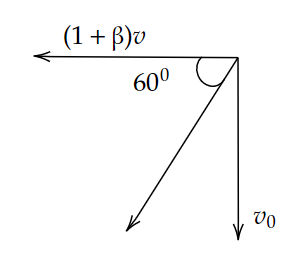
When a car is at rest, its driver sees raindrops falling on it vertically. When driving the car with speed v, he sees that raindrops are coming at an angle \[{60^0}\] from the horizontal. On further increasing the speed of the car to \[\left( {1 + \beta } \right)v\] , this angle changes to \[{45^0}\]. Then find the value of \[\beta \].
A. 0.50
B. 0.73
C. 0.37
D. 0.41
Answer
221.4k+ views
Hint: Before we start addressing the problem, let’s have a look at the data. We know that the angle of rainfall is \[{60^0}\] and changes to \[{45^0}\] upon acceleration. The initial speed of the car is v and the final speed is \[\left( {1 + \beta } \right)v\] and we need to solve for \[\beta \]. Here, the concept of relative velocity is used to solve the problem.
Formula Used:
To find the velocity of rain with respect to the car is given by,
\[\overrightarrow {{v_{RC}}} = \overrightarrow {{v_{RG}}} - \overrightarrow {{v_{CG}}} \]……….. (1)
Where, \[\overrightarrow {{v_{RG}}} \] is velocity of rain wrt ground and \[\overrightarrow {{v_{CG}}} \] is velocity of car wrt ground.
Complete step by step solution:


Image: Angle made by raindrop with respect to the ground.
Case (1): When the car is at rest, the driver sees that the raindrop is falling vertically then the velocity of the raindrop is \[{v_0}\]. i.e., in vector form, \[{v_0}\left( { - \widehat j} \right)\].
Case (2): When the driver starts the car, then he sees that the raindrops are falling at an angle of \[{60^0}\] when the car is moving with the speed of v i.e., in vector form, \[{v_0}\widehat i\].
Case (3): On further increasing the speed of the car, its velocity becomes \[\left( {1 + \beta } \right)v\] then the angle will be \[{45^0}\]. Now we need to find the \[\beta \]. i.e., in vector form, \[\left( {1 + \beta } \right)v\widehat i\]
In order to do that first, we need to find the velocity of rain with respect to the ground and the velocity of the car with respect to the ground i.e.,
\[\overrightarrow {{v_{RC}}} = \overrightarrow {{v_{RG}}} - \overrightarrow {{v_{CG}}} \]
On considering case (1) and case (2) we get,
\[\overrightarrow {{v_{RC}}} = {v_0}\left( { - \widehat j} \right) - v\widehat i\]
\[\Rightarrow \overrightarrow {{v_{RC}}} = - \left( {v\widehat i + {v_0}\widehat j} \right)\]
Now, we can find the value of \[{v_0}\]in above equation,
\[\tan {60^0} = \left( {\dfrac{{{v_0}}}{v}} \right)\]
\[\sqrt 3 = \left( {\dfrac{{{v_0}}}{v}} \right)\]
\[ \Rightarrow {v_0} = \sqrt 3 v\]……… (2)
Now, we will find \[\beta \] using equation (1) as,
\[\overrightarrow {{v_{RC}}} = \overrightarrow {{v_{RG}}} - \overrightarrow {{v_{CG}}} \]
\[\Rightarrow \overrightarrow {{v_{RC}}} = - {v_0}\widehat j - \left( {1 + \beta } \right)\widehat i\]
In order to find the value of \[{v_0}\]in above equation,
\[\tan {45^0} = \dfrac{{{v_0}}}{{\left( {1 + \beta } \right)v}}\]
\[\Rightarrow 1 = \dfrac{{{v_0}}}{{\left( {1 + \beta } \right)v}}\]
\[\Rightarrow {v_0} = \left( {1 + \beta } \right)v\]…………. (3)
Equate equations (2) and (3) we get,
\[\sqrt 3 v = \left( {1 + \beta } \right)v\]
\[ \Rightarrow \beta = \sqrt 3 - 1\]
\[ \therefore \beta = 0.732\]
Therefore, the value of \[\beta \] is 0.732
Hence, Option B is the correct answer
Note:Velocity is defined as the distance covered by an object per unit time. Velocity is a vector quantity. The apparent speed of object A to an observer travelling alongside object B is the velocity of item A in relation to object B.
Formula Used:
To find the velocity of rain with respect to the car is given by,
\[\overrightarrow {{v_{RC}}} = \overrightarrow {{v_{RG}}} - \overrightarrow {{v_{CG}}} \]……….. (1)
Where, \[\overrightarrow {{v_{RG}}} \] is velocity of rain wrt ground and \[\overrightarrow {{v_{CG}}} \] is velocity of car wrt ground.
Complete step by step solution:


Image: Angle made by raindrop with respect to the ground.
Case (1): When the car is at rest, the driver sees that the raindrop is falling vertically then the velocity of the raindrop is \[{v_0}\]. i.e., in vector form, \[{v_0}\left( { - \widehat j} \right)\].
Case (2): When the driver starts the car, then he sees that the raindrops are falling at an angle of \[{60^0}\] when the car is moving with the speed of v i.e., in vector form, \[{v_0}\widehat i\].
Case (3): On further increasing the speed of the car, its velocity becomes \[\left( {1 + \beta } \right)v\] then the angle will be \[{45^0}\]. Now we need to find the \[\beta \]. i.e., in vector form, \[\left( {1 + \beta } \right)v\widehat i\]
In order to do that first, we need to find the velocity of rain with respect to the ground and the velocity of the car with respect to the ground i.e.,
\[\overrightarrow {{v_{RC}}} = \overrightarrow {{v_{RG}}} - \overrightarrow {{v_{CG}}} \]
On considering case (1) and case (2) we get,
\[\overrightarrow {{v_{RC}}} = {v_0}\left( { - \widehat j} \right) - v\widehat i\]
\[\Rightarrow \overrightarrow {{v_{RC}}} = - \left( {v\widehat i + {v_0}\widehat j} \right)\]
Now, we can find the value of \[{v_0}\]in above equation,
\[\tan {60^0} = \left( {\dfrac{{{v_0}}}{v}} \right)\]
\[\sqrt 3 = \left( {\dfrac{{{v_0}}}{v}} \right)\]
\[ \Rightarrow {v_0} = \sqrt 3 v\]……… (2)
Now, we will find \[\beta \] using equation (1) as,
\[\overrightarrow {{v_{RC}}} = \overrightarrow {{v_{RG}}} - \overrightarrow {{v_{CG}}} \]
\[\Rightarrow \overrightarrow {{v_{RC}}} = - {v_0}\widehat j - \left( {1 + \beta } \right)\widehat i\]
In order to find the value of \[{v_0}\]in above equation,
\[\tan {45^0} = \dfrac{{{v_0}}}{{\left( {1 + \beta } \right)v}}\]
\[\Rightarrow 1 = \dfrac{{{v_0}}}{{\left( {1 + \beta } \right)v}}\]
\[\Rightarrow {v_0} = \left( {1 + \beta } \right)v\]…………. (3)
Equate equations (2) and (3) we get,
\[\sqrt 3 v = \left( {1 + \beta } \right)v\]
\[ \Rightarrow \beta = \sqrt 3 - 1\]
\[ \therefore \beta = 0.732\]
Therefore, the value of \[\beta \] is 0.732
Hence, Option B is the correct answer
Note:Velocity is defined as the distance covered by an object per unit time. Velocity is a vector quantity. The apparent speed of object A to an observer travelling alongside object B is the velocity of item A in relation to object B.
Recently Updated Pages
Uniform Acceleration Explained: Formula, Examples & Graphs

JEE Main 2022 (July 26th Shift 1) Physics Question Paper with Answer Key

JEE Main 2022 (June 26th Shift 2) Chemistry Question Paper with Answer Key

Apparent Frequency Explained: Formula, Uses & Examples

JEE Main 2023 (January 30th Shift 2) Chemistry Question Paper with Answer Key

JEE Main 2023 (April 15th Shift 1) Physics Question Paper with Answer Key

Trending doubts
JEE Main 2026: Application Form Open, Exam Dates, Syllabus, Eligibility & Question Papers

Derivation of Equation of Trajectory Explained for Students

Hybridisation in Chemistry – Concept, Types & Applications

Understanding the Angle of Deviation in a Prism

How to Convert a Galvanometer into an Ammeter or Voltmeter

Degree of Dissociation: Meaning, Formula, Calculation & Uses

Other Pages
JEE Advanced Marks vs Ranks 2025: Understanding Category-wise Qualifying Marks and Previous Year Cut-offs

Thermodynamics Class 11 Physics Chapter 11 CBSE Notes - 2025-26

Units And Measurements Class 11 Physics Chapter 1 CBSE Notes - 2025-26

NCERT Solutions For Class 11 Physics Chapter 8 Mechanical Properties Of Solids

Motion in a Straight Line Class 11 Physics Chapter 2 CBSE Notes - 2025-26

Laws of Motion Class 11 Physics Chapter 4 CBSE Notes - 2025-26




